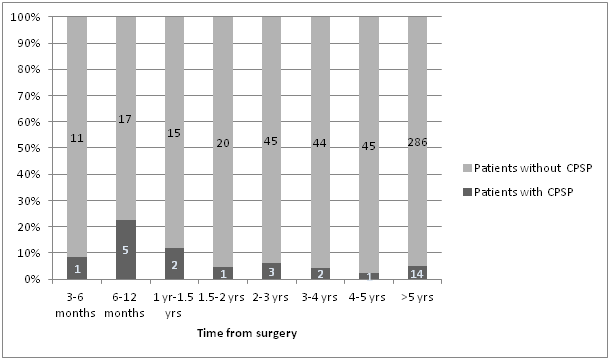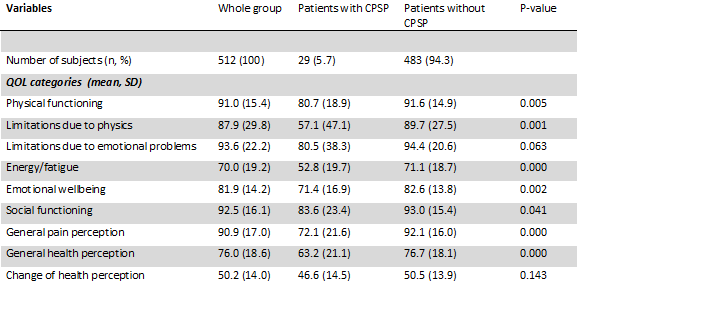Prevalence and Impact of Chronic Postsurgical Pain Following Laparoscopic Donor Nephrectomy: A Cross-Sectional Cohort Study
Moira Bruintjes1, Esmee van Helden1, Marjan de Vries1, Luuk Hilbrands2, Frank d'Ancona3, Monique Steegers4, Michiel Warlé1.
1Dept. of Surgery, Radboud University Medical Center, Nijmegen, Netherlands; 2Dept. of Nephrology, Radboud University Medical Center, Nijmegen, Netherlands; 3Dept. of Urology, Radboud University Medical Center, Nijmegen, Netherlands; 4Dept. of Anaesthesiology, Radboud University Medical Center, Nijmegen, Netherlands
Introduction:Laparoscopic donor nephrectomy (LDN) is associated with less postoperative pain, faster recovery, shorter length of hospital stay, and a quicker return to normal daily activities, when compared to open donor nephrectomy. Yet, there is a lack of knowledge about long-term outcomes following LDN, such as chronic postsurgical pain (CPSP). One study on CPSP after open donor nephrectomy reported an incidence of 21%. There are no data on the development of CPSP after LDN. Therefore, we aimed to explore the prevalence of CPSP following LDN and its impact on the health-related quality of life (HRQOL).
Materials and methods:A cross-sectional cohort study was performed among all living kidney donors who underwent a LDN at the Radboud University Medical Center Nijmegen. Patients were asked if they experienced chronic pain related to their laparoscopic donor nephrectomy, and if applicable to fill in the Mc Gill Pain questionnaire (MPQ). All donors were requested to complete the Short Form-36 Questionnaire on their HRQOL. Additionally, patients’ medical records were reviewed to obtain demographic data, relevant medical history, specifications of their surgery (side of nephrectomy, duration of surgery, complications) and early postoperative outcomes, such as severe postoperative pain, postoperative complications, and length of hospital stay. Univariate and multivariate regression analyses were performed to identify possible predictive factors in developing CPSP following LDN.
Results:A total of 862 patients underwent a LDN at the Radboud University Medical Center Nijmegen in the period from January 2003 through December 2016 and were approached for participation. Five hundred twelve patients signed informed consent and completed the questionnaires. Twenty-nine patients (5.7%) reported chronic pain related to their donor-nephrectomy. The mean time of follow-up was 75 months. The distribution of CPSP over different periods of follow-up time is depicted in Figure 1. The HRQOL of living kidney donors with CPSP was impaired when compared to donors without pain, as shown in Table 1. Logistic regression analyses revealed that severe early postoperative pain, previous abdominal surgery and preexisting backache were possible predictive factors for the development of CPSP following LDN.


Discussion: Chronic pain after LDN is a clinically relevant complication, as it is associated with an impaired quality of life. Donors with CPSP reported a reduced general health perception with major differences in limitations due to physical functioning and their level of energy. Our data indicate that candidates for LDN should be well-informed about the risk of CPSP.
Conclusion: Chronic pain following LDN is a highly relevant issue, with a substantial prevalence of 5.7% during a mean follow-up period of 6 years. Prospective future studies should pursue risk factors and strategies to reduce the incidence of CPSP after LDN.
